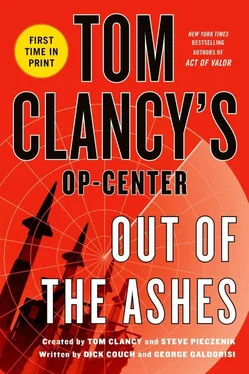“Laurie!” Sandee snapped. “We’re way beyond talking about this. What I need for you to do now is to be a good copilot and focus on the mission. We’re going into Indian country and I need you to help me. I can’t do this alone.”
Properly refocused, Laurie replied, “What would you like me to do?”
“Look at the right-hand display in front of you. You can see the coastline of Saudi Arabia on the left-hand side of the display, right?”
“Yes. Yes I can.”
“Fine. We’re going to head north until that way-point up here,” continued Sandee as she leaned over and pointed her gloved-finger at a spot on the display. “By that time we’ll have descended to below fifty feet. Once we hit that way-point we turn west and head directly for the latitude and longitude your friend at the National Reconnaissance Office gave us.”
“Is that this symbol here?” Laurie asked, pointing to the display.
“Yes. I put the latitude and longitude of this suspected site into the bird’s navigation system. The nav system will take us right there.”
“Got it.”
“Now, as we approach the coast, we’ll drop down to twenty feet off the deck. That’s really low and it will feel uncomfortable to you, but we’ve got to do everything we can to keep Saudi radars from picking us up. We’ll stay down at twenty feet as we cross the desert. Based on our speed and where this point is, I think we’ll reach it about twelve to fifteen minutes after we cross the coastline.”
“I think I’ve got all that.”
“I’m setting the radar altimeter to fifteen feet. If we drop below twenty feet and get down to fifteen, we’ll both hear a steady ‘beep, beep, beep’ tone in our headsets. Don’t assume I’ll react to it fast enough. You hear that beep-beep and you yell at me to pull up.”
“Got it. What else can I do?”
“Keep a sharp eye out on the left side of the aircraft. I can’t see much on that side from my seat. You’re my eyes out there.”
“I can do that. What else?”
“When we get about five miles from the site, I’ll pop up to about five hundred feet. I don’t think the Saudis monitor their desert with radar, just their coastline and their borders with other countries. As we get close to that final way-point we’ll look for this missile site. You told me you’ve read in intel reports the missile launchers have been taken down, so all we’re looking for is a building, right?”
“Yes, and a building that’s likely been camouflaged.”
“Got it. Five hundred feet is a good visual search altitude. There’s only so much you can camouflage. If there’s a building there, we’ll see it.”
“And then we look for the pads?”
“Yes, and that’s where I’ll need your help the most. You told me that your knowledge of all this tells us those missiles can’t be set up in sand, but need to be put on concrete pads. I’m guessing those pads are still there but will be way harder to see than a building. So keep a sharp eye out.”
“And once we have those located?” Laurie asked.
“Then I put our tail to the sun and use our FLIR to take a picture of what’s there,” Sandee continued, referring to their Forward Looking Infrared Imaging System. “The building and the pads will be all the proof we need that something was there. Once we do that, we’re dropping back down to the deck and getting our asses out of there!”
The two women continued north. Meanwhile, USS Normandy set flight quarters anticipating Swampfox 248’s imminent return.
* * *
At Forward Operating Base Tiger, as the JSOC team named the small strip in western Iraq, Brian Dawson gathered his planning team in the air-conditioned comms van. Around a small crowded table, he began by relating his conversation with Chase Williams.
“OK, team, listen up. Just got off the secure net with the boss. The situation with Syria is heating up and now Iran is moving to mine the Strait of Hormuz. The president gave him only eighteen hours to find this missile site in Saudi Arabia, otherwise we’ll be attacking Syria and doing who-knows-what to Iran.”
“Got that, sir,” Mike Volner said. “Is the plan we have in place still good?”
“Not quite. It looks as if this is going to have to be more than a special reconnaissance mission. We now have to give the president ironclad proof this false missile site is on Saudi Arabian soil, not in Syria. Just looking at it from the air or getting stand-off photos won’t be good enough. We’re going to have to go in and physically inspect the site. It will be a full-on sensitive site exploitation — that’s the mission. We have to be certain the missiles are at that location.”
“How about the extraction?” Volner asked. “The Black Hawks are still coming for us, right?”
“Correct. The two MH-60Ms will launch and head southeast. Just before they leave Iraqi airspace the Combat Talon birds will top them off so they have a full bag of gas.”
“And we’ll have no trouble with the Saudis detecting us?” Volner asked. He was the one leading the special reconnaissance mission, and he needed to ensure they had covered every possible contingency.
“No. Just before the two MH-60Ms cross into Saudi airspace, Aaron Bleich back at Op-Center is going to take down the Saudi military air traffic control system—”
“He’s sure he can do that?” Volner interrupted, knowing the Saudi Air Force would knock any intruders out of the sky first and ask questions later.
“He is. He’s already experimented by taking down a portion of their air traffic control system over their Red Sea port city of Jeddah. He knows he can cripple the entire system, and he knows about how long it would take the Saudis to bring the system back on line. We won’t have a lot of time for the extraction, but we’ll have enough.”
“So when do we go, sir?”
“Master Guns Moore, the boss says we go as soon as it’s dark and your team is ready to saddle up and jump.”
“We’ll meet here two hours before sunset for our prelaunch brief,” Mike Volner said. “We’ll be ready, sir.”
* * *
OK, Sandee, this is it. Let’s see what kind of aviator you really are, Sandee said to herself as she turned west, pushed the collective down, and pointed the nose of the aircraft toward the fly-to point now thirty-four miles dead ahead on the nose of her aircraft.
“Sharp eyes, Laurie. Sharp eyes.”
The bird streaked along near its redline speed of 135 knots, more than 150 miles per hour, making a beeline for the missile site.
God, please let us get in and out quick, and get this done .
* * *
Chase Williams stood in Op-Center’s command center looking at the array of large-screen displays and status boards and reminded himself why they had trained for so hard for so long. His watch team was quiet, composed, and there was no hint of concern or frenetic activity. It was business and nothing but business as they communicated with the JSOC team on the ground in Iraq, as well as with Aaron Bleich’s Geek Tank, while monitoring a half dozen feeds that kept them plugged into the activities of the military forces in the Central Command.
Williams had been on the phone with General Albin from time to time and was provided with status updates. Albin, for his part, had provided logistics support for Forward Operating Base Tiger, but it was more than that. As a former Central Command commander, Williams had experience that paralleled and even exceeded Albin’s. The general had on several occasions sought Williams’s advice on theater-specific issues, and he trusted that counsel.
“JSOC team is ready and they’re going to jump tonight,” his watch team lead began.
Читать дальше












